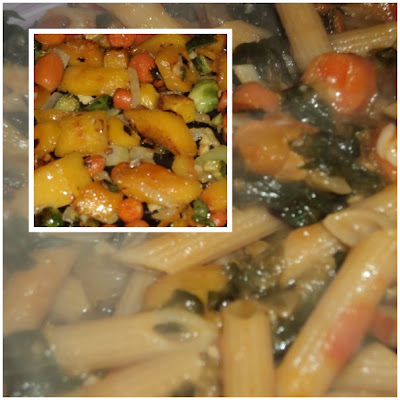Pasta Autunno
The title of this post and recipe is a play on words, or rather the name of the famous dish Pasta Primavera (click here for a recipe and the history of Pasta Primavera; click here to read about the chef who first created it). Why I say this is that the dish Pasta Primavera translates to English as "Pasta Springtime," or springtime pasta, because of the inclusion of the spring vegetables that are naturally in the original recipe and undoubtedly the time of year that it was first created (I also find the origin of the word primavera interesting; broken into two separate words--prima and vera--it means "first green"). Pasta Autunno, on the other hand means--you guessed it--Pasta Autumn. Another variation (on the recipe itself, not it's title) is that Primavera often contains cream and the vegetables may or may not be initially sauteed in butter. This version is really a variation of the classic aglio e olio, or garlic and oil. This is by far my favorite pasta preparation (OK, it's a tough tie with traditional red sauce and meatballs) and it can be applied to almost any ingredient...in fact you don't even need the pasta as a filler; using this recipe you can simply saute vegetables and serve them as a side dish. The basic recipe is this: heat good quality olive oil in a pan with garlic, hot peppers, and maybe a minced onion, cook it until it begins to brown, then add vegetables, a pinch of salt, and chicken broth (or water if you want to keep it vegetarian), and allow it to cook while you boil the pasta (inversley, if you have hard vegetables--such as those in this recipe--you may want to add them to the pan before the garlic, lest it burns). Cook the pasta al dente and add it to the skillet, allowing the pasta to finish cooking in the broth and absorb all the flavors. Many, but not all, of the vegetables I used in this recipe were in my fridge from the last fall harvest of the year (click here to see them). To read more on the actual process of cooking things algio e olio, and with more explicit photos, click here; if you'd like a tradition recipe (i.e. one that is printable), click here.



Comments